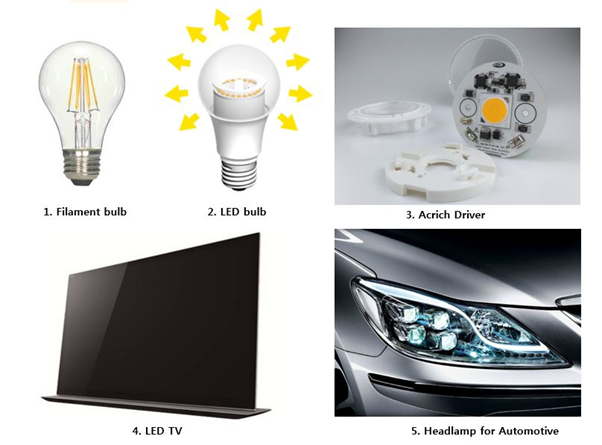Seoul Semiconductor announced on Sept. 19, 2017 that it has filed a patent infringement lawsuit, together with its affiliate, Seoul Viosys Co., Ltd., against Archipelago Lighting, Inc. in the U.S. District Court for the Central District of California.
In its complaint, Seoul asserts that Archipelago Lighting is selling various LED bulb products, including filament LED bulbs, that infringe on “twelve” (12) patents covering aspects of Seoul’s long-established Acrich technology. These Acrich patents include fundamental LED technologies, such as LED driver technology for high-voltage operation, MJT (Multi-Junction Technology), filament LED bulb structure, LED packaging, LED epitaxial growth, LED chip fabrication, etc.
In conventional LED products, one LED unit usually operates at a low voltage (3V) and high current. In order to increase brightness, one must connect many LED units through wire-bonding, but this can lead to other issues, such as an oversized, costly operating circuit, a substantial increase in manufacturing costs and defects caused by multiple wire-bonding connections.
 |
|
(Image: Seoul Semiconductor) |
Seoul’s Acrich technology resolves such problems by enabling the design of a high-voltage product with a high power output that relies on only a small number of LED units. Acrich technology does so by utilizing its innovative LED driver technology to enable high-voltage operation, as well as its unique MJT technology for mounting and integrating many LEDs within a small area. Seoul’s Acrich technology enables LED products to operate using AC power without requiring conversion to DC, minimizing power dissipation and reducing overall component count. This maximises the available space in LED products, facilitating a simple circuit design and significantly reducing the size and cost of LED products.
Acrich technology has become widely adopted not only in general lighting but also in electrical products and automotive lighting.
For example, in the general lighting market, 12V/18V high-voltage products have become increasingly popular, and there has been a significant increase in the demand for 36V/48V products. To manufacture such high-voltage products, Acrich technology is necessary to support LED driver technology for high-voltage operations with MJT technology. The innovative benefits of Acrich technology have resulted in its being applied in street lights and commercial lights in countries throughout the world, including locations as diverse as Korea, the United States, China, Europe, Southeast Asia, Mongolia and Kazakhstan.
 |
 |
|
(Images: Seoul Semiconductor) |
In electronic products, Acrich technology is being increasingly used for valuable product lines such as large-area television displays. Acrich technology enables a dramatic enhancement in the service life and efficiency of such displays by simplifying their internal system. It also dramatically reduces the size and thickness of the final product, rendering it more pleasing to consumers, by reducing the amount of internal space previously reserved for complicated electric circuits. In particular, Acrich enables full-array local dimming that enhances the contrast range of the latest ultra-thin UHD display products by providing the next generation of backlighting solutions for high-definition displays.
Acrich technology is also expanding its application to other product areas that require high LED light output, such as landscape lighting, vehicle headlamps and day driving lights as well as mobile phone flashes.
Seoul began to develop its unique Acrich technology in the mid 1990s and has continued to launch advanced, innovative Acrich products every year following its successful mass production in 2005. Based on its decades of investment in research and development, Seoul has established a large patent portfolio for Acrich technology, including rights to approximately 1,000 Acrich patents. However, with the recent increase in the demand for high-voltage LED products, several companies have begun to manufacture products that infringe on Seoul’s Acrich patents. In order to protect its hard-earned investment against such infringement, Seoul will actively enforce its patent rights against any infringers.
Dr. Ki-bum Nam, Head of Seoul’s R&D Center and Chief Technology Officer said: “We have extensively investigated copycat products infringing on Acrich technology with various LED TVs, general lighting and automotive lighting products. In order to protect Acrich technology, which has been developed with considerable resources over many decades, we will continuously take any and all legal action against infringers that disregard our valuable intellectual property.” Nam added: “Creating a fair market that respects intellectual property is important for all innovative entrepreneurs and businesses.”













